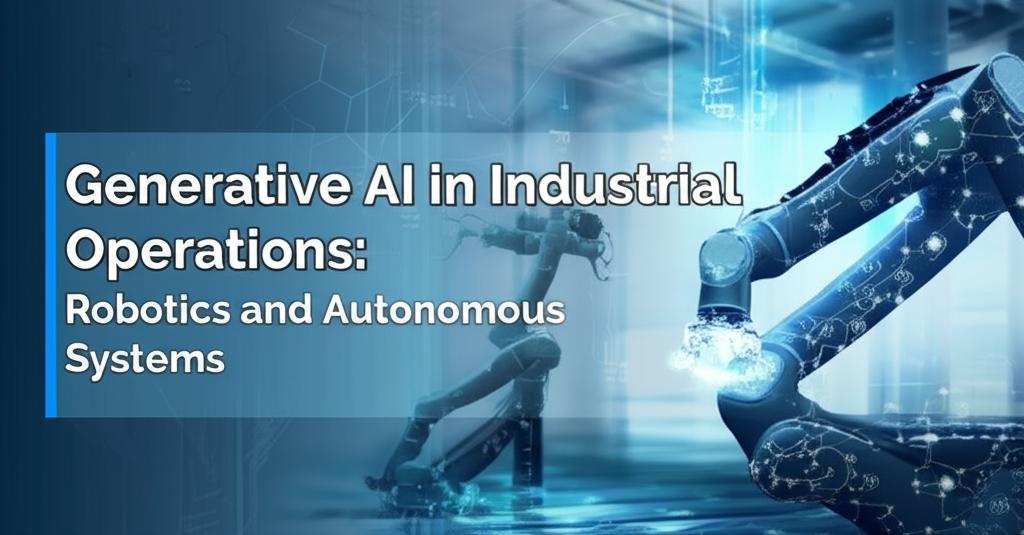Generative AI is significantly transforming industrial operations, particularly in the realms of robotics and autonomous systems. This technology is moving beyond experimental phases and becoming integral to operational strategies in manufacturing and other industrial sectors.
Key Developments and Trends:- Advanced AI Integration: Robot manufacturers are increasingly embedding generative AI-driven interfaces. This allows for more intuitive robot control using natural language instead of complex coding. As a result, robots can better understand complex situations, process natural language, and even exhibit creative problem-solving. This integration is a continuing trend expected to reshape technology and business operations.
- Autonomous Mobile Robots (AMRs): AMRs equipped with advanced navigation systems, often enhanced by generative AI, are becoming more common in logistics and warehousing. They can autonomously navigate complex environments, manage inventory, and coordinate with human workers. Machine learning algorithms enable these AMRs to continuously improve their performance and adapt to changes without human intervention.
- Human-Robot Collaboration (Cobots): Generative AI is contributing to the development of more user-friendly collaborative robots (cobots). These cobots can work seamlessly alongside humans, with intuitive interfaces and enhanced safety features that allow them to detect human presence and adjust actions accordingly. They are also capable of learning new tasks more quickly.
- Simulation and Synthetic Data Generation: Generative AI is crucial for creating realistic and diverse synthetic data for training and testing autonomous robots. This includes generating sensor inputs, environmental conditions, and even synthetic faults to evaluate system responses and safety. This capability accelerates the development and deployment of robust autonomous systems.
- Natural Language Control and Motion Generation: A significant advancement is the ability to generate robot motion from natural language descriptions. This allows experts without programming experience to instruct robots, making the deployment process faster and more accessible.
- From Traditional to Generative AI Approaches: Traditionally, autonomous systems involved separate modules for perception, planning, and control. Generative AI is enabling a shift towards end-to-end systems that combine these functions, often using Vision-Language-Action (VLA) models. These models process text instructions and visual input to predict and refine robot actions.
- Predictive Maintenance: Generative AI analyzes historical data, sensor readings, and operational patterns to predict equipment failures. This allows for proactive maintenance scheduling, reducing downtime and extending equipment lifespan.
- Enhanced Design and Optimization: In manufacturing, generative AI can explore vast design possibilities based on specified constraints, leading to innovative and efficient product designs. It helps optimize production line layouts, resource allocation, and even infrastructure planning.
- Increased Efficiency and Productivity: Automation of complex and repetitive tasks, optimized workflows, and faster production cycles contribute to significant productivity gains.
- Cost Reduction: Optimized material usage, reduced waste, lower energy consumption, and minimized downtime through predictive maintenance lead to substantial cost savings.
- Improved Safety: Robots can take over hazardous tasks, reducing risks for human workers. Enhanced sensor technology and AI-driven safety protocols in cobots also contribute to safer work environments.
- Enhanced Customization: Generative AI enables manufacturers to cater to individual customer preferences more easily, making mass customization viable.
- Sustainability: By optimizing processes, minimizing waste, and reducing energy consumption, generative AI helps manufacturers align with sustainability goals.
- Accelerated Deployment: The ability to generate code from natural language and create synthetic training data speeds up the deployment of robotic and autonomous systems.
- Data Quality and Integration: The effectiveness of generative AI models heavily relies on the quality, accuracy, and integration of vast amounts of data generated by industrial processes.
- Complexity and Interoperability: Manufacturing processes are intricate, and ensuring that generative AI systems can interoperate with existing legacy systems can be challenging.
- Security and Intellectual Property: Safeguarding sensitive manufacturing data and intellectual property when using AI models is a critical concern.
- Explainability and Trust: The "black box" nature of some AI models can hinder trust and adoption, making explainability crucial.
- High Initial Investment and Workforce Training: Implementing generative AI and robotics requires significant upfront investment and the need to upskill or reskill the workforce.
Generative AI, combined with robotics and autonomous systems, is poised to continue its transformative impact on industrial operations. The convergence of these technologies is expected to lead to even more intelligent, adaptable, and autonomous systems. We are likely to see AI moving from being a tool to a collaborative partner in industrial settings, driving further innovation, efficiency, and sustainability. As AI becomes more integrated, it will be an essential component, not just an enhancement, for industrial operations, paving the way for the next generation of intelligent manufacturing.

